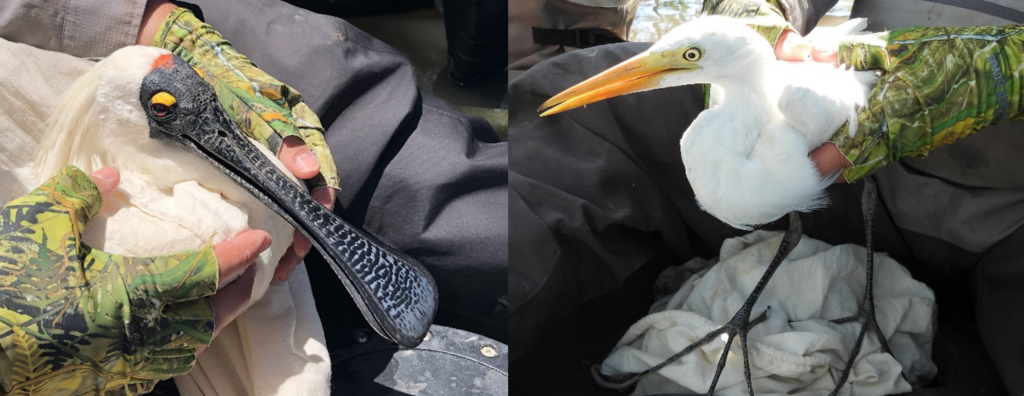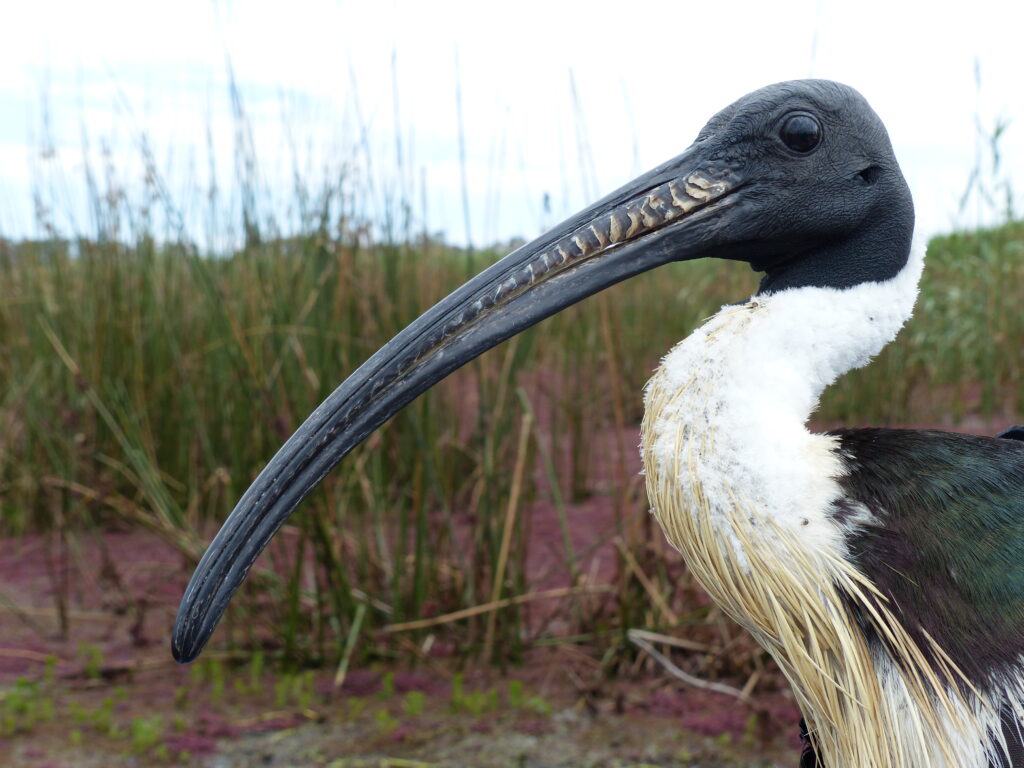Waterbird foraging
A range of bills for a range of diets!
One of the most distinctive features of waterbirds is their bills, which vary in shape, size and functionality depending on their feeding style.
Some waterbirds are ‘obligate wetland-feeders’ meaning that they are dependent on and specially adapted for eating foods that live in surface water. Both spoonbills and egrets are in this category, but their feeding strategies are very different.
The bills of spoonbills have grooves that are filled with highly sensitive sensory cells. This helps them to find prey at night or in murky water when sweeping their bill from side to side through the water to search for prey tactilely (that is, using touch). On the other hand, egrets have incredibly sharp bills and long necks that they use to hunt in shallow water by wading or standing motionless before stabbing prey that they identify visually from the surface with lightning speed. Egrets feed mostly on fish but also consume amphibians, aquatic insects and crustaceans.

Spoonbills (left) have grooves that are filled with highly sensitive sensory cells that help them to find prey in the water when sweeping their bill from side to side. Egrets (right) have sharp bills and long necks that they use to stab prey in the water that they identify visually from the surface.
Meanwhile, ibis are more ‘generalist’ in their feeding style and can find food in terrestrial environments (that is, on dry land) as well as in the water. Their long, downcurved bill is ideal for probing in soft mud, soil, grasses, and logs, but can also be used with incredible accuracy to catch things on the surface like locusts. Their ability to adapt their diet to what is available has contributed to the reputation of Australian White ibis in particular as ‘bin chickens’ – that is frequenting human environments where food is readily available, including around landfill sites and outdoor eating areas. In natural environments ibis typically feed on invertebrates, including crayfish and large insects, and small vertebrates such as frogs and fish.

Ibis have a distinctive downcurved bill that is perfect for sourcing a wide variety of food items on the surface of or underneath soft mud or soil, in the water or in drier environments. This is a straw-necked ibis, which is a different species to the more well-known Australian white ibis.
What can movement tracking tell us about waterbird foraging?
Our team’s satellite tracking of three aggregate-nesting waterbird species – straw-necked ibis, Australian white ibis, and royal spoonbill suggests that their movements are greatly affected by their foraging requirements.
To find out more about what we’ve learned about waterbird feeding during nesting and its important implications for water management, visit our Research Activities Page on Waterbird Nesting.
Outside the nesting season, we have learned that ibis and spoonbills have distinctly different movement patterns, which is likely related to the habitats they require for feeding.
Many straw-necked ibis are highly nomadic outside the breeding season and travel to very remote areas of inland Australia. They are able to do this partly because of their flexible foraging strategy, which means that they can find food in a range of environments while on the move despite an affinity for wetlands. For example, straw-necked ibis are well-known for flocking to feast on locusts in farmlands.
Below is an animation showing the movements of ‘Kenzie’, an adult male straw-necked ibis. He’s been highly mobile since we started tracking him from his nest site in February 2023. He first visited a few places relatively close to the nesting site, then moved on to the Narran Lakes area in NSW. After that he explored various places in very remote western Queensland, before deciding to head to the Northern Territory.
Australian white ibis tend to take up residency for longer periods of time than straw-necked ibis, sometimes not even leaving their breeding site in between nesting periods. In natural environments, white ibis are more dependent on aquatic food sources than straw-necked ibis, eating yabbies, fish, and aquatic invertebrates.
Below is an animation of the movements of ‘Johnny’, an Australian White Ibis. After breeding in Kow Swamp in late 2017/early 2018, he relocated to the Melbourne area in mid-2018 and stayed there for more than six months.
Meanwhile, many royal spoonbills that our team has tracked have spent most of their time moving between large lakes, rivers and coastal areas of Queensland and NSW, generally avoiding the very dry regions of inland Australia. This likely reflects their need to access surface water for foraging, and inability to feed effectively in totally dry environments.
Below is an animation of the movements of ‘Snowflake’, a juvenile royal spoonbill who, after leaving the nesting area, used a coastal route to travel to northern Queensland and spend time in the rich floodplain region of western Cape York.
